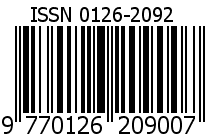Potensi kombinasi induced-pluripotent stem cells (iPSC) dan metode pengeditan gen clustered regularly interspaced short palindromic repeats–associated nuclease 9 (CRISPR-Cas9) sebagai terapi pada pasien hemofilia
Abstract
Hemofilia merupakan penyakit genetik berupa gangguan dalam pembekuan darah yang terjadi akibat mutasi pada gen yang mengkode faktor koagulasi. Anak yang mengalami hemofilia apabila tidak ditangani dengan baik akan mengakibatkan berbagai macam komplikasi yang dapat berujung kepada kematian. Pada saat sekarang ini, anak yang mengalami hemophilia memerlukan terapi pengganti atau pengobatan dengan desmopresin yang dilakukan seumur hidup dengan risiko infeksi yang tinggi. Oleh karena itu dibutuhkan suatu terapi yang dapat mengatasi penyebab dari hemofilia tersebut, satu-satunya terapi yang dapat menyembuhkan hemofilia yaitu terapi gen. Terapi gen meliputi terapi dengan menggunakan metode pengeditan gen yang fleksibel dan mudah digunakan, clustered regularly interspaced short palindromic repeats–associated nuclease 9 (CRISPR- Cas9). Metode ini mampu dengan baik memotong molekul DNA pada titik tertentu melalui aktivitas endonuklease dengan bantuan single guide RNA (sgRNA). Penggunaan metode ini dapat dikembangkan untuk dilakukan pada induced pluripotent stem cell (iPSC). Pengkombinasian teknik iPSC dan gen editing CRISPR-Cas9 pada sel pasien hemofilia dapat dihasilkan stem sel yang mampu menghasilkan faktor koagulasi yang diperlukan. Sehingga dapat mengatasi permasalahan yang mejadi penyebab dari hemofilia tersebut.
Kata kunci: Hemofilia, iPSC, CRISPR-Cas9
Keywords
Full Text:
PDFReferences
Lyu C, Shen J, Wang R, Gu H, Zhang J, Xue F, et al. Targeted genome engineering in human induced pluripotent stem cells from patients with hemophilia B using the CRISPR-Cas9 system. Stem Cell Res Ther. (2018) 9:92.
Zaiden R, Nagalla S. Hemophilia A [Internet]. 2016 [cited 25 April 2016] Available from:http://emedicine.medscape.com/article/779322-
Zaiden R, Nagalla S. Hemophilia B [Internet]. 2016 [cited 25 April 2016] Available from:http://emedicine.medscape.com/article/779434-
Nienhuis AW, Nathwani AC, Davidoff AM. Gene therapy for hemophilia. Mol Ther. 2017;25(5):1163 – 7
Nathwani AC, Reiss UM, Tuddenham EG, Rosales C, Chowdary P, McIntosh J, et al. Long-term safety and efficacy of factor IX gene therapy in hemophilia B. N Engl J Med. 2014;371(21):1994 – 2004.
Indra K, Nurhadi I. Induksi Sel Somatik Menjadi Sel Punca Pluripoten. CDK 2011; 38(5)327-334.
Xue HY, Ji LJ, Gao AM, Liu P, He JD, Lu XJ. CRISPR-Cas9 for medical genetic screens: applications and future perspectives. J Med Genet. 2016;53(2):91 – 7.
Ikatan Dokter Anak Indonesia. Pedoman Pelayanan Medis. 2009
Data & Statistics on Hemophilia. [Internet] 2019 [cited 5 February 2019] Available from:https://www.cdc.gov/ncbddd/hemophilia/data.html.
Hemophilia. https://ghr.nlm.nih.gov/conditio n/hemophilia. Diakses 5 Februari 2019
Bowen DJ. Haemophilia A and haemophilia B : molecular insights. 2002;
Jayandharan GR, Srivastava A, Srivastava A. Role of Molecular Genetics in Hemophilia : From Diagnosis to Therapy. 2012;1(212):64–78.
Singh, Vimal, Kumar, Neeraj, Kalsan, Manisha, Saini, Abhishek, Chandra, Ramesh. Mechanism of Induction: Induced Pluripotent Stem Cells (iPSCs). J Stem Cells.2015;10(1):43-62
Haase A, Olmer R, Schwanke K, Wunderlich S, Merkert S, Hess C, Zweigerdt R, Gruh I, Meyer J, Wagner S, Maier LS, Han DW, Glage S, Miller K, Fischer P, Schöler HR, Martin U. Generation of induced pluripotent stem cells from human cord blood. Cell Stem Cell 2009; 5(4): 434-41.
Zhou T, Benda C, Dunzinger S, Huang Y, Ho JC, Yang J, Wang Y, Zhang Y, Zhuang Q, Li Y, Bao X, Tse HF, Grillari J, Grillari-Voglauer R, Pei D, Esteban MA. Generation of human induced pluripotent stem cells from urine samples. Nature Protocols 2012; 7(12):2080–2089.
Carey BW, Markoulaki S, Hanna J, Saha K, Gao Q, Mitalipova M, Jaenisch R.Reprogramming of murine and human somatic cells using a single polycistronic vector. Proc Natl Acad Sci U S A. 2009;106(1): 157–162.
Zhou H, Wu S, Joo JY, Zhu S, Han DW, Lin T, Trauger S, Bien G, Yao S, Zhu Y, Siuzdak G, Schöler HR, Duan L, Ding S. Generation of induced pluripotent stem cells using recombinant proteins. Cell Stem Cell 2009; 4(5): 381-4.
Indra K, Nurhadi I. Induksi Sel Somatik Menjadi Sel Punca Pluripoten. CDK 2011; 38(5) 327-334.
Quintanilla RH, Asprer JST, Vaz C, Tanavde V and Lakshmipathy U. CD44 Is a Negative Cell Surface Marker for Pluripotent Stem Cell Identification during Human Fibroblast Reprogramming. PLoS ONE. 2014; 9(1): e85419
van der Oost J, Westra ER, Jackson RN, and Wiedenheft B. Unravelling the structural and mechanistic basis of CRISPR- Cas systems. Nat. Rev Microbiol. 2014 .12, 479–492.
Mojica FJ, Díez-Villaseñor C, García-Martínez J, and Almendros C. Short motif sequences determine the targets of the prokaryotic CRISPR defence system. Microbiology 2009;155, 733–740.
Wang H, La Russa M, and Qi LS. CRISPR/Cas9 in genome editing andbeyond. Annu. Rev. Biochem. 2016; 85: 227–264.
Baranwal, Deepak, Singh, Prakash, Kumar S, Ramesh, Solankey SS. Gene knockout technology and its application. Biologix.2013;2:55-69.
Ran FA, Hsu PD, Wright J, Agarwala V, Scott DA, and Zhang F. Genome engineering using the CRISPR-Cas9 system. Nat. Protoc. 2013;8: 2281–2308.
Park CY, Kim DH, Son JS, Sung JJ, Lee J, Bae S, Kim JH, Kim DW, and Kim JS. Functional Correction of Large Factor VIII Gene Chromosomal I nversions in Hemophilia A Patient-Derived i PSCs Using CRISPR-Cas9. Cell Stem Cell. 2015 Aug 6;17(2):213-20.





















